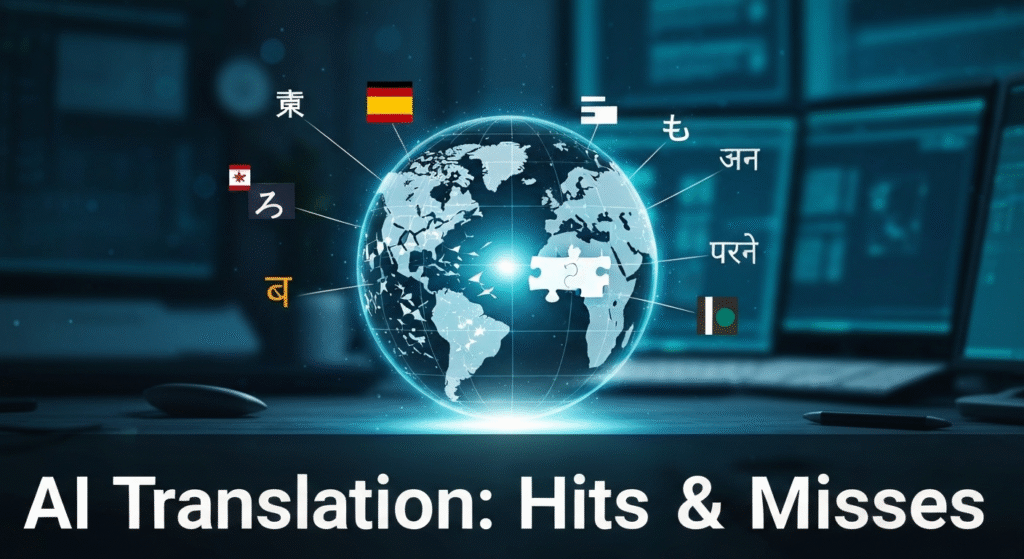AI translation tools promise a world without language barriers. With a single click, they can supposedly translate a complex business proposal, a friendly chat, or a marketing slogan into any language on Earth. It sounds amazing, but how well does it actually work when you move beyond simple phrases like “Where is the library?” Can these powerful algorithms truly grasp the subtle art of human communication, with all its culture, context, and clever wordplay? The claims are big, but the reality is often more complicated.
For years, I’ve been working with AI tools, watching them evolve from clumsy gadgets to sophisticated assistants. My curiosity lies in understanding their true limits. That’s why I decided to put some of the most popular AI translation platforms to the test. I wasn’t interested in just translating a word or two. I wanted to see how they handled real-world text—idioms, professional emails, and culturally specific ideas—across five very different languages. This is the story of that experiment: a straightforward look at where AI translation shines and where it still falls short.
As someone who has spent the last five years exploring and writing about AI, I’ve seen firsthand how quickly this technology is advancing. My goal has always been to cut through the hype and share what these tools can realistically do for us. I’m driven by a passion for understanding how AI intersects with human culture and language. This isn’t about formal credentials; it’s about countless hours spent experimenting, researching, and breaking down complex topics into clear, useful explanations for readers. My work is about sharing the journey of discovery, bringing clarity to a field that can often feel intimidating.
Setting Up a Real-World Test

To get a clear picture of AI’s capabilities, I needed a consistent and challenging testing method. My goal wasn’t just to check for grammatical accuracy but to evaluate how well the AI preserved the original intent, tone, and cultural nuance.
The Languages I Chose
I picked five languages that represent a wide range of linguistic families, grammatical structures, and cultural contexts. This diversity was crucial for pushing the AI beyond its comfort zone.
- Spanish: As a Romance language with a structure similar to English, this was expected to be one of the AI’s strongest areas.
- German: Known for its complex case system and long compound words, German presents a significant grammatical challenge.
- Japanese: With a completely different sentence structure (Subject-Object-Verb), multiple writing systems, and a deep system of honorifics (keigo), Japanese is a true test of an AI’s contextual understanding.
- Arabic: Its right-to-left script, complex verb conjugations, and significant dialectal variations make it a formidable opponent for translation engines.
- Hindi: Using the Devanagari script and having a different grammatical structure, including postpositions instead of prepositions, Hindi tests the AI’s adaptability.
The Content I Translated
I used four different types of English text to see how the AI handled various communication styles:
- A Simple Factual Statement: “The warehouse is located at 123 Industrial Drive and is open from 9 AM to 5 PM.”
- A Formal Business Email Snippet: “We need to finalize the quarterly report by Friday. Please review the attached sales figures and provide your feedback at your earliest convenience.”
- A Common Idiom: “Let’s not beat around the bush; we are over budget.”
- A Marketing Slogan: “Our software: Work smarter, not harder.”
Now, let’s break down how the AI performed with each language.
Spanish: The High Achiever with a Few Quirks
As expected, the AI performed exceptionally well with Spanish. For straightforward text, the translations were nearly flawless and ready to use.
Where It Excelled
The AI handled factual information and professional communication with impressive accuracy.
| Text Type | Original English | AI Translation (Spanish) | Analysis |
| Factual Statement | “The warehouse is located at 123 Industrial Drive and is open from 9 AM to 5 PM.” | “El almacén está ubicado en 123 Industrial Drive y está abierto de 9 AM a 5 PM.” | Excellent. A perfect, literal translation that is 100% accurate and natural. |
| Business Email | “Please review the attached sales figures and provide your feedback at your earliest convenience.” | “Por favor, revise las cifras de ventas adjuntas y envíe sus comentarios lo antes posible.” | Very Good. The translation is grammatically correct and conveys the right level of formality. “At your earliest convenience” became “as soon as possible,” which is a common and acceptable substitute. |
This level of accuracy is why AI is so useful for everyday business communication with Spanish-speaking colleagues or clients. It reliably handles the core message without introducing errors.
Where It Failed
The trouble started when the language became less literal. Idioms and creative slogans exposed the AI’s reliance on direct translation over contextual understanding.
- The Idiom Test: “Let’s not beat around the bush.”
- AI Translation: “No le demos vueltas al arbusto.”
- The Problem: This is a word-for-word translation that would sound bizarre to a native Spanish speaker. The AI translated the words, not the meaning.
- A Better Human Translation: “No nos andemos con rodeos” or “Vayamos al grano.” (Let’s get to the point.)
- The Slogan Test: “Work smarter, not harder.”
- AI Translation: “Trabaja más inteligentemente, no más duro.”
- The Problem: While technically correct, it’s clunky and lacks the punch of a good slogan. It doesn’t flow well and feels like a translation.
- A Better Human Translation: “Trabaja con ingenio, no con esfuerzo.” (Work with ingenuity, not with effort.) This captures the spirit of the slogan more effectively.
For Spanish, the AI is a fantastic tool for 90% of tasks, but for marketing or creative writing, a human touch is still essential to make the content feel natural and persuasive.
German: A Battle with Grammar
German’s strict grammatical rules proved to be a tougher challenge. While the AI often got the words right, it sometimes struggled to assemble them correctly according to German’s case and gender system.
Where It Excelled
Once again, simple factual statements were handled well. The AI seems to have a massive database of these common structures, allowing it to produce accurate translations.
- Factual Statement: “The warehouse is located at 123 Industrial Drive…”
- AI Translation: “Das Lager befindet sich am Industrial Drive 123…”
- Analysis: Excellent. The AI correctly identified “Lager” (warehouse) as a neuter noun (“Das”) and used the appropriate preposition. No issues here.
Where It Failed
Complexity was the AI’s enemy. The formal email and the idiom revealed significant weaknesses in its grammatical reasoning.
| Text Type | Original English | AI Translation (German) | Analysis |
| Business Email | “…provide your feedback at your earliest convenience.” | “…geben Sie Ihr Feedback bei Ihrer frühesten Bequemlichkeit.” | Poor. This is a painfully literal translation. “Bequemlichkeit” means convenience, but in the sense of physical comfort. No German would ever use this phrase. A human would say, “…geben Sie bitte so bald wie möglich Ihr Feedback.” (Please give your feedback as soon as possible.) |
| Idiom | “Let’s not beat around the bush.” | “Lass uns nicht um den Busch herumschlagen.” | Poor. Another literal translation that misses the point entirely. The correct German idiom is completely different: “Reden wir nicht um den heißen Brei herum.” (Let’s not talk around the hot porridge.) |
The German test showed that while AI can handle basic vocabulary, it struggles to navigate the complex web of grammatical rules and idiomatic phrases that define the language. Using AI-generated German for professional purposes without review from a native speaker is a risky move.
Japanese: The Contextual Abyss

Japanese was the language that most clearly demonstrated the limitations of current AI technology. Its reliance on context, honorifics, and implied meaning creates a minefield for algorithms trained on Western language structures.
Where It Excelled
To my surprise, the AI did a decent job with the simple factual statement, choosing a neutral and clear way to express the information.
- Factual Statement: “The warehouse is open from 9 AM to 5 PM.”
- AI Translation: 「倉庫は午前9時から午後5時まで開いています。」 (Sōko wa gozen kuji kara gogo goji made aiteimasu.)
- Analysis: Good. This is a clear, grammatically correct, and natural-sounding sentence. It uses the standard polite form (“-masu”), which is a safe choice for this type of information.
Where It Failed
In almost every other area, the AI failed to grasp the necessary context, particularly the social context embedded in the Japanese language.
- The Business Email Test: “Please review the attached sales figures and provide your feedback…”
- AI Translation: 「添付の売上高を確認し、ご意見をお聞かせください。」 (Tenpu no uriagedaka o kakunin shi, goiken o okikase kudasai.)
- The Problem: This translation is too direct and lacks the appropriate level of politeness and humility required in Japanese business communication. It sounds like a command, not a request.
- A Better Human Translation: 「添付の売上データをご確認いただき、ご意見をいただけますと幸いです。」 (Tenpu no uriage dēta o go kakunin itadaki, goiken o itadakemasuto saiwaidesu.) This version uses humble forms (“go kakunin itadaki”) and a softer request (“itadakemasuto saiwaidesu” – I would be grateful if I could receive your feedback), which is crucial for professional relationships.
- The Slogan Test: “Work smarter, not harder.”
- AI Translation: 「より賢く働き、より懸命に働かない。」 (Yori kashikoku hataraki, yori kenmei ni hatarakanai.)
- The Problem: This is a robotic, negative-sounding translation that completely misses the motivational spirit of the slogan. It’s grammatically awkward and has zero marketing appeal.
- A Better Human Translation: 「努力より、工夫を。」 (Doryoku yori, kufū o.) This is much more poetic and effective, translating to “Rather than effort, ingenuity.”
For Japanese, AI can be a starting point for understanding a text, but it cannot be trusted for any communication that requires social awareness, politeness, or persuasive power. The cultural layer of the language remains largely invisible to the algorithm.
Arabic and Hindi: Navigating Different Scripts and Structures
Both Arabic and Hindi presented unique challenges related to their scripts and grammatical foundations. The results were mixed, showing that the AI’s performance can be inconsistent even with widely spoken languages.
Common Strengths
For both languages, the AI successfully translated the simple factual statement with high accuracy. It correctly handled the different scripts (Arabic’s Abjad and Hindi’s Devanagari) and basic sentence structures. This suggests the models are well-trained on foundational, informational text.
Common Weaknesses
The main failures were, once again, in the realm of nuance and cultural context.
Arabic Failures:
- Idiom: The AI’s attempt to translate “beat around the bush” was laughably literal, resulting in a phrase about physically striking a shrub. The correct Arabic idiom, like 「لا تدور وتلف」 (la tador wa talif – don’t spin and turn), is conceptually different.
- Formality: The AI struggled to consistently apply the correct level of formality. The translation of the business email felt stiff and unnatural, lacking the polite and slightly elaborate phrasing common in professional Arabic correspondence.
Hindi Failures:
- Slogan: The AI translated “Work smarter, not harder” into a dry, literal phrase: 「अधिक स्मार्ट काम करें, अधिक मेहनत नहीं。」 (Adhik smart kaam karen, adhik mehnat nahin). This lacks any rhythm or impact. A human marketer might opt for something more evocative like 「मेहनत से नहीं, दिमाग से काम लो。」 (Mehnat se nahin, dimaag se kaam lo – Work not with hard work, but with your mind).
- Word Choice: In the business email, the AI sometimes chose words that were technically correct but not the most common or professional choice, a subtle mistake that instantly marks the text as a translation.
The Verdict: AI is a Powerful Assistant, Not a Replacement

After testing across these five languages, a clear pattern emerged. AI translation is incredibly powerful for a specific purpose: getting the basic meaning of a literal, low-context text. However, it is not a substitute for a skilled human translator.
Here’s a summary of its core capabilities versus its limitations:
| AI Translation Strengths | AI Translation Weaknesses |
| Factual Information: Excels at translating technical manuals, addresses, and data. | Cultural Nuance: Fails to understand context, politeness, and social hierarchy. |
| Gist Translation: Excellent for quickly understanding the main points of an email or article. | Idioms and Slang: Translates words literally, missing the figurative meaning entirely. |
| First Drafts: Provides a solid base that a human can then refine and perfect. | Marketing and Creative Copy: Cannot replicate the creativity, emotion, and persuasive power needed for slogans and branding. |
| High-Resource Languages: Performs best with widely spoken languages like Spanish that have vast amounts of training data. | Grammatical Complexity: Struggles with complex case systems (German) or unique sentence structures (Japanese). |
This experiment reinforced a key lesson I’ve learned from my years working with AI: it is a tool for efficiency, not a replacement for expertise. You can use it to work faster, but you can’t use it to replace deep knowledge, whether that’s understanding German grammar or navigating Japanese business etiquette. For a more detailed look into the research behind neural machine translation, studies published in resources like the ACL Anthology provide deep insights into the technology’s evolution and current challenges.
Frequently Asked Questions (FAQs)
What is the most accurate AI translation tool?
There isn’t one “most accurate” tool for everything. Some models are better with European languages, while others have improved their handling of Asian languages. The accuracy depends more on the type of text and the language pair than on a specific brand. For literal text, most major platforms are highly comparable.
Can AI translators understand context?
AI can understand immediate context within a sentence or paragraph, which helps it choose the right words (e.g., “book” a flight vs. read a “book”). However, it struggles with broader cultural and social context, such as the relationship between speakers, which is crucial for languages like Japanese.
Is AI translation good enough for business use?
It depends on the task. For internal communications where the goal is simply to understand the message, it’s often sufficient. For external, client-facing content, legal documents, or marketing materials, using raw AI translation is highly risky and can damage your brand’s credibility. It should only be used as a first step, followed by review from a native speaker.
Will AI replace human translators?
It’s unlikely. AI will change the role of a translator, making them more of an editor and cultural consultant. The AI can handle the repetitive, literal work, freeing up the human expert to focus on the nuanced, creative, and culturally sensitive aspects of translation that machines can’t replicate.
Conclusion: Use the Tool, But Know Its Limits
AI translation is a remarkable technology that has made the world more connected. It can provide instant access to information and break down basic communication barriers with incredible speed. My experiments show that for tasks requiring literal accuracy, especially in widely spoken languages like Spanish, AI is an invaluable assistant.
However, language is more than just a collection of words; it’s a reflection of culture, history, and human connection. This is where AI currently falls short. It doesn’t understand why a phrase might be polite in one culture and rude in another. It can’t capture the clever wordplay of a marketing slogan or the subtle respect conveyed in a business email. As we continue to integrate these tools into our work, the key is to approach them with realistic expectations. Use them to build bridges, but let human wisdom and cultural understanding be the final architects.


